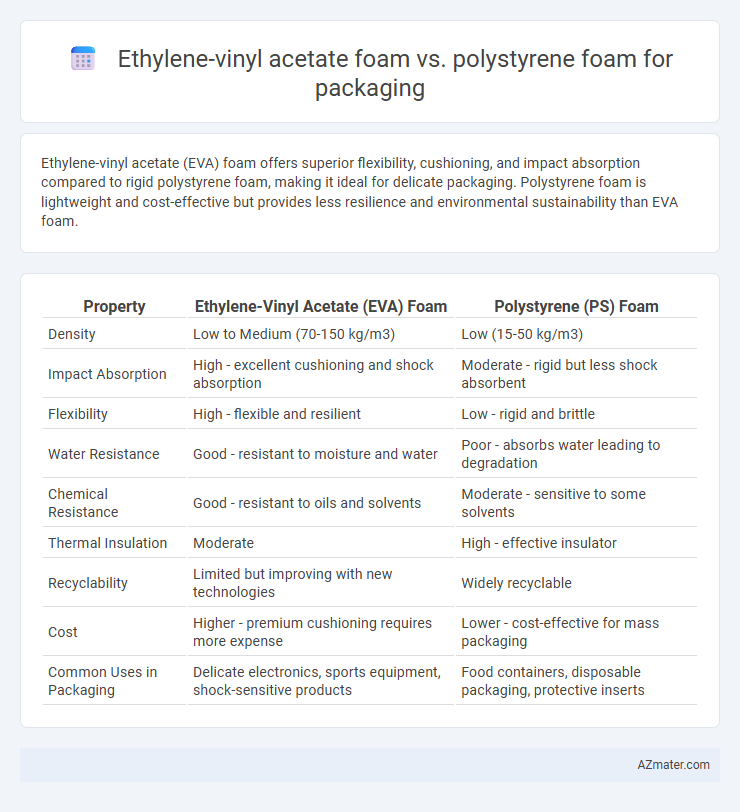Ethylene-vinyl acetate (EVA) foam offers superior flexibility, cushioning, and impact absorption compared to rigid polystyrene foam, making it ideal for delicate packaging. Polystyrene foam is lightweight and cost-effective but provides less resilience and environmental sustainability than EVA foam.
Table of Comparison
| Property | Ethylene-Vinyl Acetate (EVA) Foam | Polystyrene (PS) Foam |
|---|---|---|
| Density | Low to Medium (70-150 kg/m3) | Low (15-50 kg/m3) |
| Impact Absorption | High - excellent cushioning and shock absorption | Moderate - rigid but less shock absorbent |
| Flexibility | High - flexible and resilient | Low - rigid and brittle |
| Water Resistance | Good - resistant to moisture and water | Poor - absorbs water leading to degradation |
| Chemical Resistance | Good - resistant to oils and solvents | Moderate - sensitive to some solvents |
| Thermal Insulation | Moderate | High - effective insulator |
| Recyclability | Limited but improving with new technologies | Widely recyclable |
| Cost | Higher - premium cushioning requires more expense | Lower - cost-effective for mass packaging |
| Common Uses in Packaging | Delicate electronics, sports equipment, shock-sensitive products | Food containers, disposable packaging, protective inserts |
Introduction to Packaging Foams
Ethylene-vinyl acetate (EVA) foam offers superior flexibility, impact resistance, and cushioning properties compared to polystyrene foam, making it ideal for delicate and irregularly shaped packaging applications. Polystyrene foam, often used in protective packaging, excels in rigidity, lightweight structure, and moisture resistance but lacks the elasticity and durability of EVA foam. EVA foam's ability to absorb shocks and vibrations enhances product protection during transportation, whereas polystyrene provides cost-effective thermal insulation and structural support.
Overview of Ethylene-Vinyl Acetate (EVA) Foam
Ethylene-vinyl acetate (EVA) foam is a soft, flexible material characterized by excellent shock absorption, resilience, and chemical resistance, making it ideal for protective packaging applications. Unlike polystyrene foam, EVA offers superior cushioning and durability, with enhanced resistance to cracking and UV degradation. Its closed-cell structure combined with light weight and water resistance improves product safety during transportation and storage.
Overview of Polystyrene (PS) Foam
Polystyrene (PS) foam is a lightweight, rigid material widely used in packaging for its excellent cushioning and shock absorption properties. It offers superior thermal insulation and moisture resistance, making it ideal for protecting sensitive products during shipping. Its cost-effectiveness and ease of molding into various shapes contribute to its popularity in packaging applications.
Key Physical Properties Comparison
Ethylene-vinyl acetate (EVA) foam exhibits superior elasticity and impact absorption compared to polystyrene foam, making it ideal for cushioning fragile items during shipping. EVA foam's closed-cell structure provides excellent moisture resistance and flexibility, while polystyrene foam is more rigid and prone to cracking under stress. Thermal insulation performance is higher in polystyrene foam due to its low density and closed-cell configuration, but EVA foam outperforms in durability and repeated-load resilience.
Cushioning Performance and Shock Absorption
Ethylene-vinyl acetate (EVA) foam demonstrates superior cushioning performance and shock absorption compared to polystyrene foam due to its elastic and flexible cellular structure, which efficiently dissipates impact forces. EVA foam offers higher energy absorption and resilience, making it ideal for packaging fragile and sensitive items that require repeated protection during handling and transport. In contrast, polystyrene foam is rigid and brittle, providing less effective shock absorption and a higher risk of cracking under stress.
Weight and Density Differences
Ethylene-vinyl acetate (EVA) foam typically exhibits lower density, ranging from 30 to 120 kg/m3, compared to polystyrene foam's density of 15 to 50 kg/m3, influencing their packaging weight profiles. EVA foam's higher density results in increased weight, offering better cushioning and impact resistance for heavy or fragile goods. Polystyrene foam is favored for lightweight packaging due to its low density, optimizing shipping costs while providing rigid protection for less delicate items.
Environmental Impact and Recyclability
Ethylene-vinyl acetate (EVA) foam offers better environmental performance than polystyrene foam due to its lower toxicity and improved biodegradability, reducing long-term ecological harm. Unlike polystyrene, which is notoriously difficult to recycle and often ends up in landfills or oceans, EVA foam has higher recyclability rates, contributing to waste reduction efforts. The use of EVA foam in packaging supports sustainability goals through its potential for chemical recycling and lower greenhouse gas emissions during production.
Cost-Effectiveness Analysis
Ethylene-vinyl acetate (EVA) foam typically offers greater cost-effectiveness in packaging due to its superior cushioning properties and durability, which reduce product damage and returns. Polystyrene foam, while cheaper per unit volume, often leads to higher overall costs from increased breakage and environmental disposal fees. Evaluating total lifecycle expenses, EVA foam presents a more economically viable solution for protecting delicate or high-value items during transit.
Best Applications for Each Foam
Ethylene-vinyl acetate (EVA) foam excels in packaging fragile electronics and medical devices due to its superior flexibility, impact absorption, and resistance to cracking under stress. Polystyrene foam, particularly expanded polystyrene (EPS), is ideal for packaging heavy or temperature-sensitive items such as appliances and food products because of its rigid structure, excellent thermal insulation, and cost-effectiveness. Choosing EVA foam enhances protection against vibration and shock in delicate items, while polystyrene is preferred for lightweight, insulating packaging that requires structural support.
Choosing the Right Foam for Your Packaging Needs
Ethylene-vinyl acetate (EVA) foam offers superior cushioning, flexibility, and resistance to impact, making it ideal for fragile or irregularly shaped items, while polystyrene foam provides excellent rigidity and thermal insulation suited for lightweight, protective packaging. For products requiring shock absorption and durability, EVA foam ensures better protection against vibrations and compressions during transit. Polystyrene foam is cost-effective and efficient for packaging that demands high structural support and moisture resistance, commonly used in electronics and food packaging industries.

Infographic: Ethylene-vinyl acetate foam vs Polystyrene foam for Packaging
 azmater.com
azmater.com